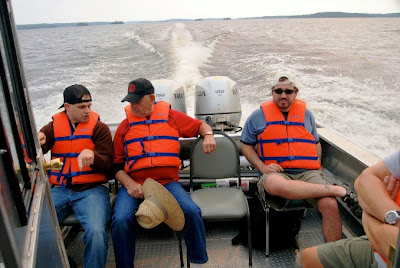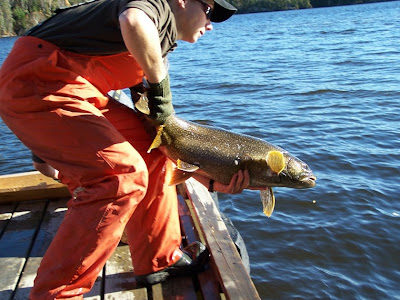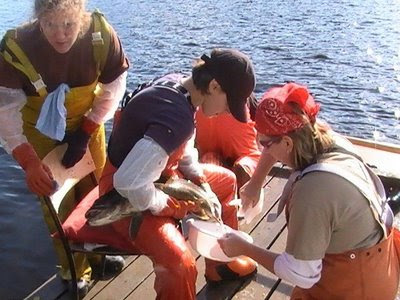
In a little more than a month from now we will make our first trip of the season with guests to Bow Narrows Camp, 20 miles by water from the town of Red Lake.
Our cabin cruiser, the Lickety Split, can make this journey with 9 passengers in as little as 35 minutes in favorable weather.
It's a beautiful journey, past islands, through narrows, and alongside of ducks and loons. We sometimes encounter moose, deer and black bear swimming from island to island.
There are several things you can do to help make this trip from the parking lot in Red Lake to your cabin at camp go as smooth as possible.
You will already have been given a pickup time to meet the Lickety Split in Red Lake. If everything is working according to plan, and the wind and waves allow us to travel at normal cruising speed, each round-trip takes 90 minutes, including loading-unloading.
When you reach the parking lot, back your vehicle up to the dock and unload onto the large wagon waiting there. Take the wagon to the end of the dock and off-load your luggage and fishing gear, leaving the wagon -- and a travel lane on the dock -- clear for guests leaving camp. This will let us quickly unload the boat and take on your gear.
Dan will show you a designated parking spot.
After a quick goodbye to the departing guests, we will be on our way to camp.
Unless your group is exactly eight or nine people, there will likely be more than your party aboard the boat. All the luggage is going to be placed in the same place in the boat; so, make sure you can easily identify yours when we get to camp. (Some duct tape and a marker are great for this.) This is especially true for cases of refreshments.
We will form a human-chain to relay the luggage into the hold of the boat.
Once at camp, a couple of our staff usually form the chain inside the boat while the guests make up the chain on the dock. This lets them sort the luggage as it comes off the boat.
Then the next group's luggage is put on the boat for the outgoing trip and we're off again.
It's a real help to all of us if none of the luggage items weighs more than 40-50 pounds. This includes coolers.
Another helpful tip is not to have lots of loose items like shoes and flashlights. Stick them all in a duffel bag or packsack brought just for this purpose.
We don't place a weight limit on you like the fly-in camps do but obviously, weight is a consideration. The boat can only carry so much of it. We just ask you to use your head. Don't bring heavy items if you can avoid it.
A good rule of thumb is if each person has one duffel bag or suitcase, one tackle box, a couple of cases of refreshments and a rod case.
Speaking of refreshments, please bring beer and soft drinks in cans, not bottles, as they are much lighter. Liquor and wine, of course, usually only come in bottles so there's no other way of bringing those.
If coming on the Housekeeping Plan, you can avoid the necessity of back-breaking coolers by buying your groceries in Red Lake instead of hauling them all the way from home. Believe it or not Red Lake has a modern supermarket with virtually the same items you have available in your stores, including fresh produce, probably from the same sources as in your home town.
The prices at Sobeys Supermarket in Red Lake are comparable to at home, especially when converted to American dollars. You may also be able to bring a smaller vehicle or fewer vehicles on the trip if you don't need space for grocery coolers. You can either buy your groceries just before catching the boat to camp or if staying the night in Red Lake, buy them the previous night and have them stored at the store.
If you do buy food at Sobeys in Red Lake, ask to have it packed in cardboard boxes. This is done all the time at the store and it allows us to pack your food into the boat without anything becoming damaged.
Click to go back to our
websiteClick to see the latest on the
blog





















